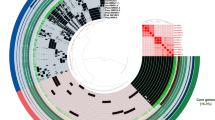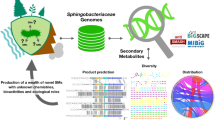Abstract
The recent advances in omics and computational analysis have enabled the capacity to identify the exclusive strain-specific metabolites and novel biosynthetic gene clusters. This study analyzed eight strains of P. aurantiaca including GS1, GS3, GS4, GS6, GS7, FS2, ARS38, PBSt2, one strain of P. chlororaphis RP4, one strain of P. aeruginosa (At1RP4), and one strain of P. fluorescens (RS1) for the production of rhamnolipids, quorum-sensing signals, and osmolytes. Seven rhamnolipid derivatives were variably detected in fluorescent pseudomonads. These rhamnolipids included Rha-C10-C8, Rha-Rha-C10-C10, Rha-C10-C12db, Rha-C10-C10, Rha-Rha-C10-C12, Rha-C10-C12, and Rha-Rha-C10-C12db. Pseudomonas spp. also showed the variable production of osmoprotectants including N-acetyl glutaminyl glutamine amide (NAGGN), betaine, ectoine, and trehalose. Betaine and ectoine were produced by all pseudomonads, however, NAGGN and trehalose were observed by five and three strains, respectively. Four strains including P. chlororaphis (RP4), P. aeruginosa (At1RP4), P. fluorescens (RS1), and P. aurantiaca (PBSt2) were exposed to 1– 4% NaCl concentrations and evaluated for the changes in phenazine production profile which were negligible. AntiSMASH 5.0 platform showed 50 biosynthetic gene clusters in PB-St2, of which 23 (45%) were classified as putative gene clusters with ClusterFinder algorithm, five (10%) were classified as non-ribosomal peptides synthetases (NRPS), five (10%) as saccharides, and four (8%) were classified as putative fatty acids. The genomic attributes and comprehensive insights into the metabolomic profile of these Pseudomonas spp. strains showcase their phytostimulatory, phyto-protective, and osmoprotective effects of diverse crops grown in normal and saline soils.





Similar content being viewed by others
Data availability
No specific data of this manuscript is identified for data availability.
References
Allison TM, Castric P (2016) Selective distribution of Pseudomonas aeruginosa O-antigen among strains producing group I pilin. FEMS Pathogens Dis. https://doi.org/10.1093/femspd/ftv102
Amrein H, Makart S, Granado J, Shakya R, Schneider-Pokorny J, Dudler R (2004) Functional analysis of genes involved in the synthesis of syringolin A by Pseudomonas syringae pv. syringae B301 D-R. Mol Plant Microbe Interact 17:90–97. https://doi.org/10.1094/MPMI.2004.17.1.90
Baldeweg F, Kage H, Sebastian S, Allen C, Hoffmeister D, Nett M (2017) Structure of ralsolamycin the interkingdom morphogen from the crop plant pathogen Ralstonia solanacearum. Org Lett 19:4868–4871. https://doi.org/10.1021/acs.orglett.7b02329
Basnet DB, Oh TJ, Vu TT, Sthapit B, Liou K, Lee HC, Yoo JC, Sohng JK (2006) Angucyclines Sch 47554 and Sch 47555 from Streptomyces sp. SCC-2136: cloning, sequencing, and characterization. Mol Cells 22:154–162
Biggins JB, Ternei MA, Brady SF (2012) Malleilactone, a polyketide synthase-derived virulence factor encoded by the cryptic secondary metabolome of Burkholderia pseudomallei group pathogens. J Am Chem Soc 134:13192–13195. https://doi.org/10.1021/ja3052156
Blin K, Shaw S, Steinke K, Villebro R, Ziemert N, Lee SY et al (2019) antiSMASH 5.0: updates to the secondary metabolite genome mining pipeline. Nucleic Acids Res 47:W81–W87
Cellini A, Donati I, Fiorentini L, Vandelle E, Polverari A, Venturi V et al (2020) N-Acyl homoserine lactones and Lux solos regulate social behaviour and virulence of Pseudomonas syringae pv. actinidiae. Microbial Ecol 79:383–396
Cesa-Luna C, Geudens N, Girard L, De Roo V, Maklad HR, Martins JC, Höfte M, De Mot R (2023) Charting the ipopeptidome of nonpathogenic Pseudomonas. Msystems 8:e00988-e1022. https://doi.org/10.1128/msystems.00988-22
Chen XH, Koumoutsi A, Scholz R, Eisenreich A, Schneider K, Heinemeyer I et al (2007) Comparative analysis of the complete genome sequence of the plant growth-promoting bacterium Bacillus amyloliquefaciens FZB42. Nat Biotechnol 25:1007–1014
Chevrette MG, Carlson CM, Ortega HE et al (2019) The antimicrobial potential of Streptomyces from insect microbiomes. Nat Commun. https://doi.org/10.1038/s41467-019-08438-0
Choi KR, Cho JS, Cho IJ, Park D, Lee SY (2018) Markerless gene knockout and integration to express heterologous biosynthetic gene clusters in Pseudomonas putida. Metabol Eng 47:463–474
Clough SE, Jousset A, Elphinstone JG, Friman VP (2022) Combining in vitro and in vivo screening to identify efficient Pseudomonas biocontrol strains against the phytopathogenic bacterium Ralstonia solanacearum. Microbiol Open 11:e1283
D’aes J, Kieu NP, Léclère V, Tokarski C, Olorunleke FE, De Maeyer K et al (2014) To settle or to move? The interplay between two classes of cyclic lipopeptides in the biocontrol strain Pseudomonas CMR12a. Environ Microbiol 16:2282–2300. https://doi.org/10.1111/1462-2920.12462
Dar D, Thomashow LS, Weller DM, Newman DK (2020) Global landscape of phenazine biosynthesis and biodegradation reveals species-specific colonization patterns in agricultural soils and crop microbiomes. Elife 9:e59726
Davis BD (1949) The isolation of biochemically deficient mutants of bacteria by means of penicillin. Proc Natl Acad Sci 35:1–10
Deveau A, Gross H, Palin B, Mehnaz S, Schnepf M, Leblond P et al (2016) Role of secondary metabolites in the interaction between Pseudomonas fluorescens and soil microorganisms under iron-limited conditions. FEMS Microbiol Ecol 92:fiw107
Favre L, Ortalo-Magné A, Greff S, Pérez T, Thomas OP, Martin JC, Culioli G (2017) Discrimination of four marine biofilm-forming bacteria by LC-MS metabolomics and influence of culture parameters. J Proteome Res 16:1962–1975
Ferreira NP, Ximenez GR, Chiavelli LU, Lucca DL, Santin SM, Zuluaga MY et al (2020) Acyl-homoserine lactone from plant-associated Pseudomonas sp. influences Solanum lycopersicum germination and root growth. J Chem Ecol 46:699–706
Freund JR, Mansfield CJ, Doghramji LJ, Adappa ND, Palmer JN, Kennedy DW et al (2018) Activation of airway epithelial bitter taste receptors by Pseudomonas aeruginosa quinolones modulates calcium, cyclic-AMP, and nitric oxide signaling. J Biol Chem 293:9824–9840. https://doi.org/10.1074/jbc.RA117.001005
Gerbino E, Carasi P, Mobili P, Serradell M, Gómez-Zavaglia A (2015) Role of S-layer proteins in bacteria. World J Microbiol Biotechnol. https://doi.org/10.1007/s11274-015-1952-9
Khatri S, Sazinas P, Strube ML, Ding L, Dubey S, Shivay YS, Sharma S, Jelsbak L (2023) Pseudomonas is a key player in conferring disease suppressiveness in organic farming. Plant Soil 18:1–20. https://doi.org/10.1007/s11104-023-05927-6
King EO, Ward MK, Raney DE (1954) Two simple media for the demonstration of pyocyanin and fluorescin. J Lab Clinical Med 44:301–307
MacLean BX, Pratt BS, Egertson JD, MacCoss MJ, Smith RD, Baker ES (2018) Using skyline to analyze data-containing liquid chromatography, ion mobility spectrometry, and mass spectrometry dimensions. J Am Soc Mass Spectrom 29:2182–2188
Masschelein J, Jenner M, Challis GL (2017) Antibiotics from Gram-negative bacteria: a comprehensive overview and selected biosynthetic highlights. Nat Prod Rep 34:712–783. https://doi.org/10.1039/c7np00010c
Mehnaz S, Bauer JS, Gross H (2014) Complete genome sequence of the sugar cane endophyte Pseudomonas aurantiaca PB-St2, a disease-suppressive bacterium with antifungal activity toward the plant pathogen Colletotrichum falcatum. Genome Announc 2:e01108–e01113. https://doi.org/10.1128/genomeA.01108-13
Mullins AJ, Webster G, Kim HJ, Zhao J, Petrova YD, Ramming CE, Jenner M, Murray JA, Connor TR, Hertweck C, Challis GL (2021) Discovery of the Pseudomonas polyyne protegencin by a phylogeny-guided study of polyyne biosynthetic gene cluster diversity. Mbio 12:e00715-e721
Nishu SD, No JH, Lee TK (2022) Transcriptional response and plant growth promoting activity of Pseudomonas fluorescens DR397 under drought stress conditions. Microbiol Spectr 10:e00979-e1022
Oni FE, Kieu Phuong N, Höfte M (2015) Recent advances in Pseudomonas biocontrol. In: Murillo J, Vinatzer BA, Jackson RW, Arnold DL (eds) Bacterial-plant interactions: advance research and future trends. Caister Academic Press, Poole, pp 167–198
Orozco-Mosqueda MDC, Duan J, DiBernardo M, Zetter E, Campos-García J, Glick BR, Santoyo G (2019) The production of ACC deaminase and trehalose by the plant growth promoting bacterium Pseudomonas sp. UW4 synergistically protect tomato plants against salt stress. Front Microbiol 10:1392. https://doi.org/10.3389/fmicb.2019.01392
Palazzotto E, Weber T (2018) Omics and multi-omics approaches to study the biosynthesis of secondary metabolites in microorganisms. Curr Opin Microbiol 45:109–116
Patil S, Paradeshi J, Chaudhari B (2016) Suppression of charcoal rot in soybean by moderately halotolerant Pseudomonas aeruginosa GS-33 under saline conditions. J Microbiol 56:889–899
Rahimi K, Lotfabad TB, Jabeen F, Ganji SM (2019) Cytotoxic effects of mono-and di-rhamnolipids from Pseudomonas aeruginosa MR01 on MCF-7 human breast cancer cells. Colloids Surf B 181:943–952
Ringel MT, Brüser T (2018) The biosynthesis of pyoverdines. Microbial Cell 5:424
Robineau M, Le Guenic S, Sanchez L, Chaveriat L, Lequart V, Joly N, Calonne M, Jacquard C, Declerck S, Martin P, Dorey S (2020) Synthetic mono-rhamnolipids display direct antifungal effects and trigger an innate immune response in tomato against Botrytis cinerea. Molecules 25:3108
Schmid J, Sperl N, Sieber V (2014) A comparison of genes involved in sphingan biosynthesis brought up to date. Appl Microbiol Biotechnol 98:7719–7733. https://doi.org/10.1007/s00253-014-5940-z
Seyedsayamdost MR (2014) High-throughput platform for the discovery of elicitors of silent bacterial gene clusters. PNAS 111:7266–7271
Shahid I, Rizwan M, Baig DN, Saleem RS, Malik KA, Mehnaz S (2017) Secondary metabolites production and plant growth promotion by Pseudomonas chlororaphis subsp. aurantiaca strains isolated from cotton, cactus, and para grass. J Microbiol Biotechnol 27:480–491
Shahid I, Han J, Hardie D, Baig DN, Malik KA, Borchers CH, Mehnaz S (2021) Profiling of antimicrobial metabolites of plant growth promoting Pseudomonas spp. isolated from different plant hosts. 3 Biotech 11:1–14
Shi J, Chen Y, Liu X, Li D (2021) Rhamnolipid production from waste cooking oil using newly isolated halotolerant Pseudomonas aeruginosa M4. J Clean Product 278:123879
Sun S, Zhou L, Jin K, Jiang H, He YW (2016) Quorum sensing systems differentially regulate the production of phenazine-1-carboxylic acid in the rhizobacterium Pseudomonas aeruginosa PA1201. Sci Rep 6:1–14
Tan IKP, Foong CP, Tan HT, Lim H, Zain NAA, Tan YC et al (2020) Polyhydroxyalkanoate (PHA) synthase genes and PHA-associated gene clusters in Pseudomonas spp. and Janthinobacterium spp. isolated from Antarctica. J Biotechnol 313:18–28
Trapet P, Avoscan L, Klinguer A, Pateyron S, Citerne S, Chervin C, Mazurier S, Lemanceau P, Wendehenne D, Besson-Bard A (2016) The Pseudomonas fluorescens siderophore pyoverdine weakens Arabidopsis thaliana defense in favor of growth in iron-deficient conditions. Plant Physiol 171:675–693. https://doi.org/10.1104/pp.15.01537
Vallet-Gely I, Novikov A, Augusto L, Liehl P, Bolbach G, Péchy-Tarr M et al (2010) Association of hemolytic activity of Pseudomonas entomophila, a versatile soil bacterium, with cyclic lipopeptide production. Appl Environ Microbiol 76:910–921. https://doi.org/10.1128/AEM.02112-09
Wang M, Carver JJ, Phelan VV, Sanchez LM, Garg N, Peng Y et al (2016) Sharing and community curation of mass spectrometry data with Global Natural Products Social Molecular Networking. Nat Biotechnol 34:828–837
Wood TL, Gong T, Zhu L, Miller J, Miller DS, Yin B, Wood TK (2018) Rhamnolipids from Pseudomonas aeruginosa disperse the biofilms of sulfate-reducing bacteria. NPJ Biofilms Microbiol 4:1–8
Woodcock SD, Syson K, Little RH, Ward D, Sifouna D, Brown JKM et al (2021) Trehalose and α-glucan mediate distinct abiotic stress responses in Pseudomonas aeruginosa. PLoS Genet 17:e1009524. https://doi.org/10.1371/journal.pgen.1009524
Zhao H, Liu YP, Zhang LQ (2019) In silico and genetic analyses of cyclic lipopeptide synthetic gene clusters in Pseudomonas sp. 11K1. Front Microbiol 10:544. https://doi.org/10.3389/fmicb.2019.00544
Zhao F, Han S, Zhang Y (2020) Comparative studies on the structural composition, surface/interface activity and application potential of rhamnolipids produced by Pseudomonas aeruginosa using hydrophobic or hydrophilic substrates. Bioresour Technol 295:122269
Acknowledgements
Authors are grateful to Muhmmad Adeel (English Language Expert) for editing the manuscript.
Author information
Authors and Affiliations
Contributions
IS wrote the manuscript and performed practical work. CHB and JH helped in LCMS data analysis. Heatmap and statistical analysis was performed by SH. SM conceived the study, edited the manuscript and HAE proofread the manuscript.
Corresponding author
Ethics declarations
Conflict of interest
All authors declare that they have no conflict of interest.
Ethical statement
This article does not contain any studies with human participants or animals performed by any of the authors.
Ethical approval
Not applicable.
Consent to participate
Not applicable.
Consent for publication
Not applicable.
Supplementary Information
Below is the link to the electronic supplementary material.
Rights and permissions
Springer Nature or its licensor (e.g. a society or other partner) holds exclusive rights to this article under a publishing agreement with the author(s) or other rightsholder(s); author self-archiving of the accepted manuscript version of this article is solely governed by the terms of such publishing agreement and applicable law.
About this article
Cite this article
Shahid, I., Han, J., Hanook, S. et al. Genome mining of Pseudomonas spp. hints towards the production of under-pitched secondary metabolites. 3 Biotech 13, 182 (2023). https://doi.org/10.1007/s13205-023-03607-x
Received:
Accepted:
Published:
DOI: https://doi.org/10.1007/s13205-023-03607-x




